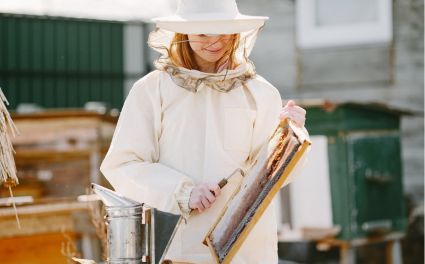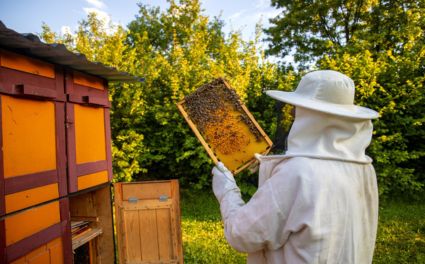Lighting a bee smoker is one of the first essential skills every beekeeper must master. Whether you’re inspecting your hive, collecting honey, or learning the basics of beekeeping, a well-lit smoker keeps your honey bees calm and cooperative. Smoke masks the alarm pheromones that bees release, allowing the beekeeper to work smoothly and confidently.
However, achieving that perfect cool, steady smoke takes patience, practice, and the right technique. Let’s explore in detail how to prepare, light, and maintain a smoker safely—plus which beekeeping equipments you’ll need for a seamless experience.
🧰 Preparation: Setting Up for a Safe Start
Before striking a match, preparation is key. Begin by gathering all your essentials—your smoker, lighter or matches, and suitable fuel. Common fuels include pine needles, burlap, wood chips, cardboard, or dried grass. They burn slowly and produce a cool, thick smoke that’s gentle on the bees.
A clean smoker performs best. Remove any leftover ash or debris from previous use to ensure steady airflow. A clogged chamber restricts oxygen and causes inconsistent smoke output. Cleaning also prevents contamination that could affect hive hygiene or honey quality.
Always suit up before working with fire or bees. Protective gear such as beekeeping jackets, beekeeping gloves, and beekeeping veils shields you from potential stings while maintaining comfort and flexibility. For younger learners or families, beekeeping kids suits ensure safety for budding beekeepers.

🔥 Lighting the Smoker: Step-by-Step
1. Loosely Fill the Chamber
Start by placing a handful of your chosen fuel loosely into the smoker. Avoid packing it tightly—airflow is vital for combustion and steady smoke. Many experienced beekeepers prefer layering fuel, starting with smaller dry materials at the bottom and denser items like wood shavings above.
2. Ignite from Below
Use a lighter or matches to ignite the bottom layer. Pump the bellows a few times to encourage the flame. When the flame catches, gently close the lid while continuing to puff the bellows. This directs oxygen into the chamber and starts producing smoke.
If you’re wearing a full beekeeping suit or beekeeping trousers, ensure your sleeves and ankle cuffs are secure to avoid any bee entry. Adding beekeeping ankle protection provides extra comfort during outdoor sessions.
3. Build and Regulate the Flame
Once lit, add more fuel gradually, puffing the bellows between each layer. The goal is to have a smoldering fire, not an open flame. When the smoke becomes cool, dense, and steady, your smoker is ready for use.
🌫️ Maintaining a Steady Flow of Smoke
Consistency is everything when managing a hive. Keep an eye on the fuel level throughout the session—add more material before the smoke starts thinning. Avoid overstuffing, as this can choke the airflow and extinguish the flame.
Adjusting the Airflow
Use the bellows gently to maintain oxygen flow. Quick, short puffs produce bursts of smoke ideal for calming bees when opening the hive. For longer inspections, slow rhythmic pumping ensures continuous smoke without overheating the chamber.
Adjusting airflow also lets you control the intensity of smoke, depending on the colony’s temperament. Calm hives may only need a few gentle puffs at the entrance, while more defensive colonies might require denser smoke around the frames.
(Also read: The Science Behind Beekeeping Smokers)
🐝 Why Smoke Matters in Beekeeping
Smoke is not just a tool; it’s communication. When bees detect smoke, they instinctively prepare to evacuate by filling up on honey. This feeding response makes them less likely to sting. At the same time, smoke masks the pheromones bees release to alert others of danger.
A calm colony means less stress on both the bees and the beekeeper. Wearing quality gear such as beekeeping jackets and beekeeping gloves ensures you stay protected while maintaining focus on hive management.
If you’re curious about the behavioral differences between pollinators and other stinging insects, explore Bee Nest vs Wasp Nest or Do Bee Suits Protect from Wasps?
🧤 Safety Measures Every Beekeeper Should Follow
1. Wear Proper Protective Gear
Always wear protective clothing. Full-body beekeeping suits with integrated veils and long gloves keep you safe during hive inspections. OZ Armour, a globally trusted brand among professional and hobbyist beekeepers, is known for designing breathable yet durable gear such as pink bee suits that combine style and safety.
2. Handle Fire with Caution
Bee smokers operate at high temperatures. Avoid touching the metal parts directly and always place the smoker on a non-flammable surface when not in use. Keep away from dry grass or wooden materials. When refueling, puff the bellows lightly to maintain airflow instead of blowing into the chamber.
3. Extinguish and Store Safely
After finishing your inspection, close the smoker’s lid to suffocate the flame. When completely cool, remove the ash and store it in a dry, safe location—ideally away from flammable objects. Proper storage extends the life of your smoker and keeps your beekeeping equipment organized.
For any accidental stings, learn the right way of removing a bee sting to prevent infection or swelling.
🧠 Additional Tips for Lighting a Smoker
-
Use dry fuel—moist materials can cause thick, acrid smoke harmful to bees.
-
Practice before hive inspections to perfect your timing and smoke control.
-
Never use plastic or treated wood—they release toxic fumes.
-
Keep spare fuel and matches in your tool kit or smoker pouch.
-
If the smoker goes out mid-inspection, reignite from remaining embers instead of starting over.
Learning such techniques is part of becoming an expert beekeeper. Dive into Learn Beekeeping to explore more hands-on guides, from hive management to honey collection.
🐝 Understanding Bee Behavior Around Smoke
Smoke affects bee communication in subtle ways. The moment it enters the hive, bees focus on protecting their stores of honey rather than defending the colony. This temporary distraction gives beekeepers the opportunity to inspect frames, locate the queen, or harvest honey.
However, excessive smoke can agitate bees or contaminate honey. Use only gentle, cool smoke and limit exposure time. Watching honey bees interact calmly under proper conditions provides valuable insight into their instincts and hierarchy.
Curious to know how long bees live or how they sustain colonies? Explore The Secret Lives of Bees for fascinating details about their life cycle.
🌸 The Connection Between Smokers and Eco-Friendly Beekeeping
Sustainable beekeeping isn’t just about honey—it’s about harmony. A well-used smoker supports humane hive management, ensuring the colony’s health while minimizing stress. Pairing ethical practices with reliable OZ Armour protective gear—like beekeeping veils or beekeeping trousers—promotes both safety and sustainability.
Smokers also play a role in distinguishing different hive types. For example, identifying whether you’re working with a beehive or wasp nest can prevent accidents. Read Difference Between a Beehive and a Wasp Nest for insights.
🧒 Beekeeping for Beginners and Families
Introducing children to beekeeping can be a rewarding experience. Teaching them how to light a smoker safely encourages patience, respect for nature, and environmental awareness. With beekeeping kids suits and lightweight gloves, young learners can observe hive behavior up close without risk.
Beekeeping fosters curiosity about insect diversity too—understanding differences such as bumblebee vs honeybee or bumblebee vs carpenter bee helps children appreciate how various species contribute to ecosystems.

🐝 Final Thoughts
Lighting and managing a bee smoker may seem simple, but mastering it defines your journey toward confident beekeeping. From fuel selection to airflow control, each step influences the calmness of your bee nest and the safety of your hive work.
By wearing reliable protective clothing like beekeeping suits, gloves, jackets, and ankle protection, beekeepers can manage colonies comfortably while respecting the natural rhythm of the bees.
OZ Armour remains a trusted name among professionals for crafting protective wear that merges safety with comfort—allowing beekeepers worldwide to focus on their passion with peace of mind.
To continue your learning journey, explore Read More Blogs About Beekeeping or visit the Learn Beekeeping section to gain expert insights into hive health, honey production, and eco-friendly management.
With the right skills, tools, and attitude, every beekeeper—whether a hobbyist or a professional—can turn a simple smoker into one of the most powerful tools for nurturing thriving bee colonies.












